外研社英语选修6 Module 3 张树玲 教案
- 格式:doc
- 大小:79.00 KB
- 文档页数:6

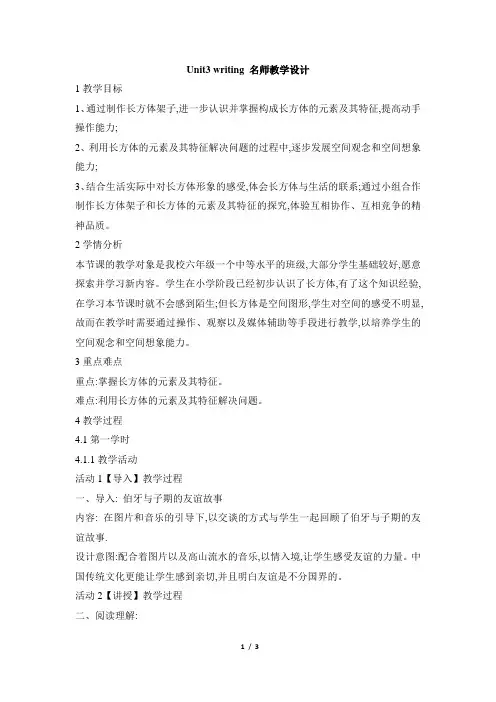
Unit3 writing 名师教学设计1教学目标1、通过制作长方体架子,进一步认识并掌握构成长方体的元素及其特征,提高动手操作能力;2、利用长方体的元素及其特征解决问题的过程中,逐步发展空间观念和空间想象能力;3、结合生活实际中对长方体形象的感受,体会长方体与生活的联系;通过小组合作制作长方体架子和长方体的元素及其特征的探究,体验互相协作、互相竞争的精神品质。
2学情分析本节课的教学对象是我校六年级一个中等水平的班级,大部分学生基础较好,愿意探索并学习新内容。
学生在小学阶段已经初步认识了长方体,有了这个知识经验,在学习本节课时就不会感到陌生;但长方体是空间图形,学生对空间的感受不明显,故而在教学时需要通过操作、观察以及媒体辅助等手段进行教学,以培养学生的空间观念和空间想象能力。
3重点难点重点:掌握长方体的元素及其特征。
难点:利用长方体的元素及其特征解决问题。
4教学过程4.1第一学时4.1.1教学活动活动1【导入】教学过程一、导入: 伯牙与子期的友谊故事内容: 在图片和音乐的引导下,以交谈的方式与学生一起回顾了伯牙与子期的友谊故事.设计意图:配合着图片以及高山流水的音乐,以情入境,让学生感受友谊的力量。
中国传统文化更能让学生感到亲切,并且明白友谊是不分国界的。
活动2【讲授】教学过程二、阅读理解:1. 题目分析内容:分析题目,并且指出阅读故事时应注意的要点:who, what happened in different stages in the story。
设计意图:题目对于阅读非常关键,往往可以暗示给读者很多信息,题目的分析可以让学生更加明确在阅读时应注意的要素。
2. 预测文章内容:根据阅读文章的开始、结尾预测本文。
设计意图:预测文章,在阅读前做好心理准备。
3. 快速阅读内容:学生对教师所示重点短语进行划线、理解、排序。
设计意图:通过教师所示重点短语理清文章发展的先后顺序,对于重点短语go through进行点拨。

外研book6module3reading and speaking教学设计New Standard English Book 6Module 3 Interpersonal Relationships---FriendshipRoy's Story(reading and speaking)Ⅰ.Teaching Material and Students1.Teaching Material:The teaching material is the reading part from New Standard English, Book 6 –Module 3 “Interpersonal Relationships---Friendship” titled Roy's Story.2.Students:The students are from Grade 2 who have enough vocabulary to understand the story and the basic reading skills and speaking skills.Ⅱ.Teaching aims1. Knowledge objects1). Help students find out some key words and retell the story .2). Help students to get the general idea and specific information .2. Ability objects1). To improve students' skimming and scanning ability .2). To develop students' abilities of communication.3. Emotion objects1). To develop the ability to solve the problems .2). To enlarge the view of understanding friendship .Ⅲ. Important &Difficult points1. Important points1). To help students find the time clue.2). To learn some useful reading skills (to find key words)2. Difficult points1). How to retell the story according to the key words.2). How to get the structure of a passage.Ⅳ. Teaching Aids and Methods1. Teaching Aids1). Multi-media computer2). PowerPoint 20193). Whiteboard2. Teaching Methods1). Task-based teaching method2). Inductive teaching methods3). Communicative teaching methodⅤ. Teaching Procedurethe first time I met him Roy was telling a joke, and everyone Part 1(para__ to __)burst out laughing. five years later Roy’s father was knocked over, Part 2(para__ )he changed completely.three months ago Roy was going through others’ pockets. Part 3(para__ to __)last week Our school raised money for a charity,but it was stolen.Part 4(para__ to __)this weekend I found 500 pound in Roy’s pocket.Purpose of my design:1. To have a further understanding of the story.2. To attain a complete reading process through“words--phrases--sentences-paragraphs-structure”.Task 4: (Individual work)Read the story part by part, and answer the questions.Part1:1.What was Roy like before his father died? (popular, outgoing,friendly)2.What kind of relationship did Roy and Daniel have?(good friends, trust)Part2:1. Why did Roy change? (knock over, move, financially )2. How did he change? (silent, moody, lost interest in, lost friends)Part3:1.What happened in the cloakroom that surprised Daniel? ( go through, wallet )2.What’s Daniel’s reaction ? ( fall open, turn around, without saying a word) Part4:1. What happened to the£500?(stolen )2.How did Daniel know who had stolen it? (cold, waiting for, put on )Purpose of my design:1. To teach the students to catch the key words of each part.2. To prepare for retelling the story according to the key words.Task5 (Individual work; pair work)Retell the story according to the given words. They are all key words! Try to add more key words to your own story.Purpose of my design:1. To learn the ability to retell the story according to the key words.2. To check achievements .Step 4. Post-readingFree Talk:1. Is Roy really a bad guy?2. Is Daniel a good friend?3. What do you think about D aniel’s silence for Roy’s theft?4. Do you think it is good to cover your friend’s shortcoming?After that, ask them:What kind of people should you make friends with?Purpose of my design:1. To enhance students' ability to communicate and deal with problems when making friends.2. To guide students to set up a right view of making friends and keeping friends. After that, ask them:Does friendship only exist in human society?Purpose of my design:1. To enable the students to know the rich meanings of friendship .2. To open up our minds and cultivate their divergent thinking(发散性思维). Step 5. Homework1. Try to retell the story to your friends,which must involve all of the key words.2. Try to write your own ending to the story. Let's share them next class. Purpose of my design:1. To enable the students to consolidate what they have learnt.2. To develop their ability of writing.Step 6. Blackboard DesignModule 3 Interpersonal Relationships---FriendshipRoy's StoryTime → events → structure shy friendlykey words →paragraphs → passage close friendschatrely onsharetreasure Teaching Reflection:1.As time is so limited, there is no time for more students to show their retelling stories.So I should fasten the reading time properly.2.Some students have difficulty in finding out key words, I should give them more care after class.3.There are some students who can not participate the process of activities, I should think it over and give some advice.。
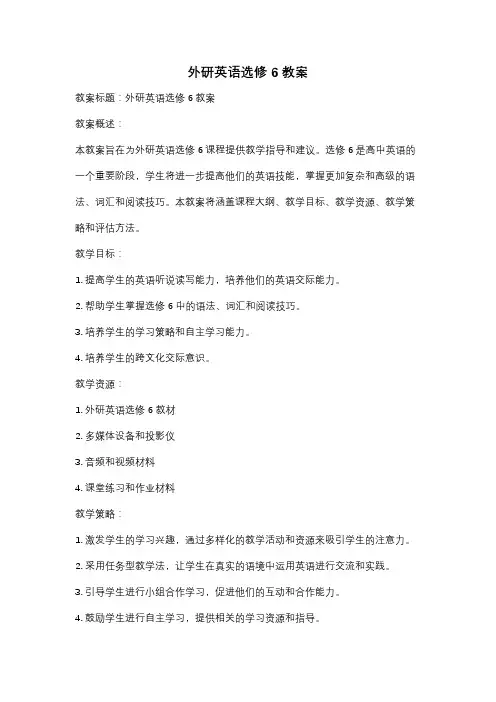
外研英语选修6教案教案标题:外研英语选修6教案教案概述:本教案旨在为外研英语选修6课程提供教学指导和建议。
选修6是高中英语的一个重要阶段,学生将进一步提高他们的英语技能,掌握更加复杂和高级的语法、词汇和阅读技巧。
本教案将涵盖课程大纲、教学目标、教学资源、教学策略和评估方法。
教学目标:1. 提高学生的英语听说读写能力,培养他们的英语交际能力。
2. 帮助学生掌握选修6中的语法、词汇和阅读技巧。
3. 培养学生的学习策略和自主学习能力。
4. 培养学生的跨文化交际意识。
教学资源:1. 外研英语选修6教材2. 多媒体设备和投影仪3. 音频和视频材料4. 课堂练习和作业材料教学策略:1. 激发学生的学习兴趣,通过多样化的教学活动和资源来吸引学生的注意力。
2. 采用任务型教学法,让学生在真实的语境中运用英语进行交流和实践。
3. 引导学生进行小组合作学习,促进他们的互动和合作能力。
4. 鼓励学生进行自主学习,提供相关的学习资源和指导。
教学步骤:1. 导入:通过引入相关话题或问题,激发学生的学习兴趣,并调动他们的背景知识。
2. 语言输入:通过教师讲解、多媒体展示和讨论等方式,向学生介绍新的语法、词汇和阅读材料。
3. 语言实践:通过角色扮演、对话练习、听力理解和口语表达等活动,让学生在真实的语境中运用所学内容。
4. 语言输出:通过写作练习、演讲和小组讨论等活动,让学生巩固和运用所学的语言知识。
5. 总结与评价:总结本节课的学习内容,评价学生的学习情况,并提供反馈和指导。
评估方法:1. 日常表现评估:观察学生在课堂上的参与度、积极性和合作能力。
2. 课堂练习和作业评估:通过作业和练习题来评估学生对所学内容的掌握程度。
3. 口语评估:通过口语表达活动和演讲来评估学生的口语交际能力。
4. 笔试评估:通过期中考试和期末考试来评估学生对所学知识的理解和应用能力。
以上是对外研英语选修6教案的一个概括性建议和指导。
具体的教案内容和活动设计可以根据教师的实际情况和学生的需求进行调整和修改。
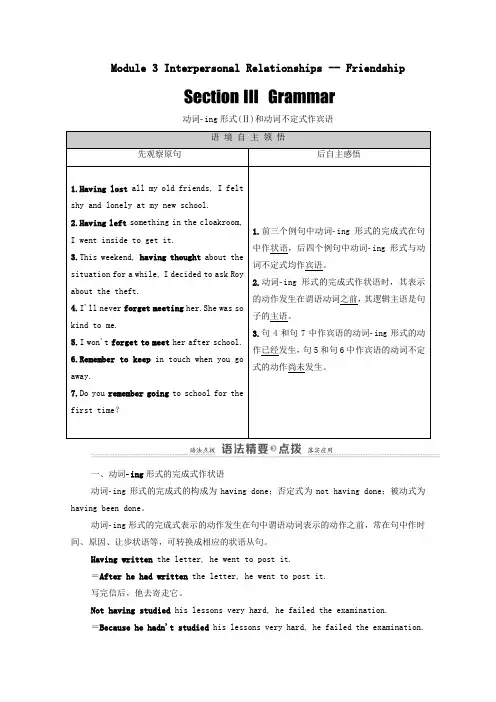
Module 3 Interpersonal Relationships -- Friendship动词ing形式(Ⅱ)和动词不定式作宾语语境自主领悟先观察原句后自主感悟1.Having lost all my old friends, I feltshy and lonely at my new school.2.Having left something in the cloakroom,I went inside to get it.3.This weekend, having thought about the situation for a while, I decided to ask Roy about the theft.4.I'll never forget meeting her.She was so kind to me.5.I won't forget to meet her after school.6.Remember to keep in touch when you go away.7.Do you remember going to school for the first time?1.前三个例句中动词ing形式的完成式在句中作状语,后四个例句中动词ing形式与动词不定式均作宾语。
2.动词ing形式的完成式作状语时,其表示的动作发生在谓语动词之前,其逻辑主语是句子的主语。
3.句4和句7中作宾语的动词ing形式的动作已经发生,句5和句6中作宾语的动词不定式的动作尚未发生。
一、动词ing形式的完成式作状语动词in g形式的完成式的构成为having done;否定式为not having done;被动式为having been done。
动词ing形式的完成式表示的动作发生在句中谓语动词表示的动作之前,常在句中作时间、原因、让步状语等,可转换成相应的状语从句。
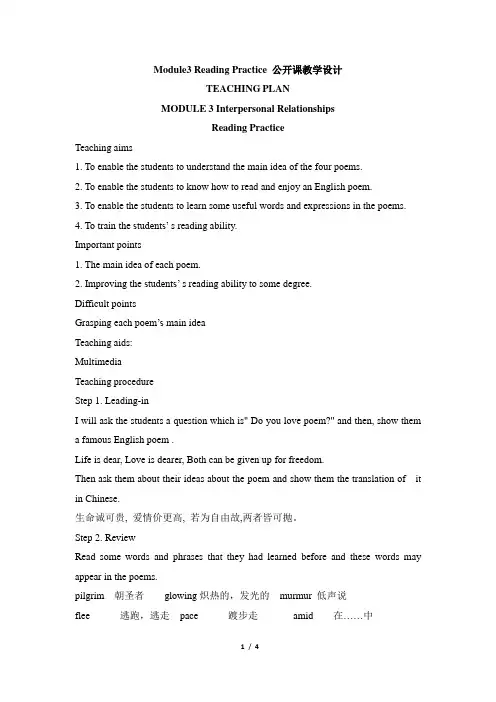
Module3 Reading Practice 公开课教学设计TEACHING PLANMODULE 3 Interpersonal RelationshipsReading PracticeTeaching aims1. To enable the students to understand the main idea of the four poems.2. To enable the students to know how to read and enjoy an English poem.3. To enable the students to learn some useful words and expressions in the poems.4. To train the students’ s reading ability.Important points1. The main idea of each poem.2. Improving the students’ s reading ability to some degree.Difficult pointsGrasping each poem’s main ideaTeaching aids:MultimediaTeaching procedureStep 1. Leading-inI will ask the students a question which is" Do you love poem?" and then, show thema famous English poem .Life is dear, Love is dearer, Both can be given up for freedom.Then ask them about their ideas about the poem and show them the translation of it in Chinese.生命诚可贵, 爱情价更高, 若为自由故,两者皆可抛。
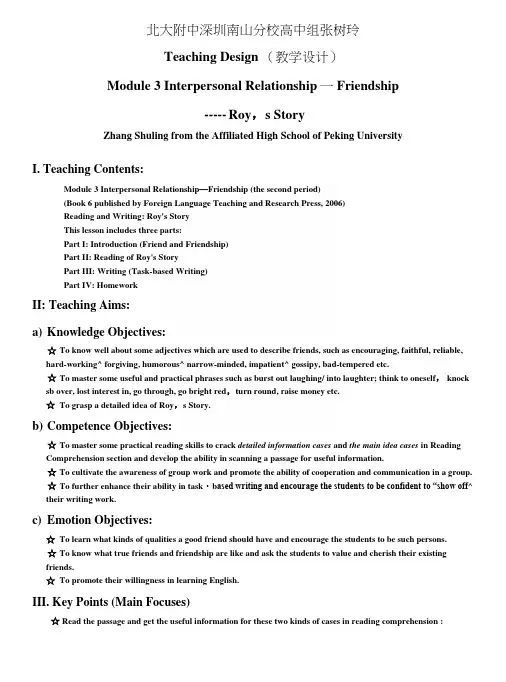
北大附中深圳南山分校高中组张树玲Teaching Design (教学设计)Module 3 Interpersonal Relationship一Friendship----- Roy,s StoryZhang Shuling from the Affiliated High School of Peking UniversityI. Teaching Contents:Module 3 Interpersonal Relationship—Friendship (the second period)(Book 6 published by Foreign Language Teaching and Research Press, 2006)Reading and Writing: Roy's StoryThis lesson includes three parts:Part I: Introduction (Friend and Friendship)Part II: Reading of Roy's StoryPart III: Writing (Task-based Writing)Part IV: HomeworkII: Teaching Aims:a)Knowledge Objectives:☆To know well about some adjectives which are used to describe friends, such as encouraging, faithful, reliable, hard-working^ forgiving, humorous^ narrow-minded, impatient^ gossipy, bad-tempered etc.☆To master some useful and practical phrases such as burst out laughing/ into laughter; think to oneself, knock sb over, lost interest in, go through, go bright red,turn round, raise money etc.☆To grasp a detailed idea of Roy,s Story.b)Competence Objectives:☆To master some practical reading skills to crack detailed information cases and the main idea cases in Reading Comprehension section and develop the ability in scanning a passage for useful information.☆To cultivate the awareness of group work and promote the ability of cooperation and communication in a group.☆To further enhance their ability in task・b ased writing and encourage the students to be confident to “show off^ their writing work.c)Emotion Objectives:☆To learn what kinds of qualities a good friend should have and encourage the students to be such persons.☆To know what true friends and friendship are like and ask the students to value and cherish their existing friends.☆To promote their willingness in learning English.III. Key Points (Main Focuses)☆ Read the passage and get the useful information for these two kinds of cases in reading comprehension :impatient narrow-minded bad-temperedncouraging\faithfureliable ---- ■乔nRTH?trickyhumorousoffensive forgivingetc ...pon怡。
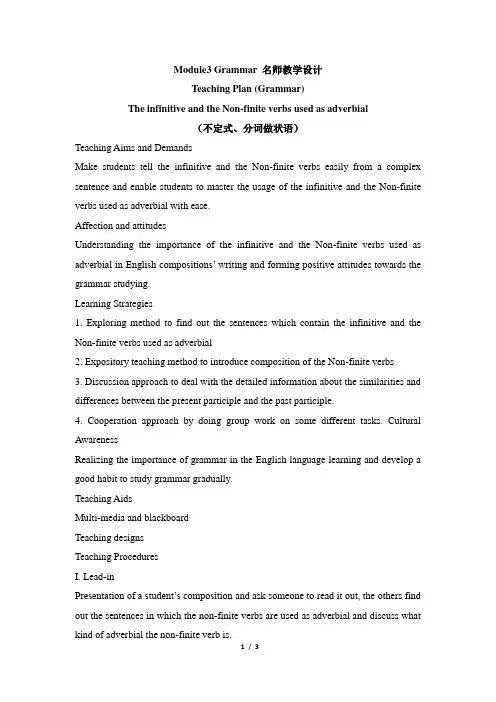
Module3 Grammar 名师教学设计Teaching Plan (Grammar)The infinitive and the Non-finite verbs used as adverbial(不定式、分词做状语)Teaching Aims and DemandsMake students tell the infinitive and the Non-finite verbs easily from a complex sentence and enable students to master the usage of the infinitive and the Non-finite verbs used as adverbial with ease.Affection and attitudesUnderstanding the importance of the infinitive and the Non-finite verbs used as adverbial in English compositions’ writing and forming posit ive attitudes towards the grammar studying.Learning Strategies1. Exploring method to find out the sentences which contain the infinitive and the Non-finite verbs used as adverbial2. Expository teaching method to introduce composition of the Non-finite verbs3. Discussion approach to deal with the detailed information about the similarities and differences between the present participle and the past participle.4. Cooperation approach by doing group work on some different tasks. Cultural AwarenessRealizing the importance of grammar in the English language learning and develop a good habit to study grammar gradually.Teaching AidsMulti-media and blackboardTeaching designsTeaching ProceduresI. Lead-inPresentation of a student’s composition and ask someone to read it out, the others find out the sentences in which the non-finite verbs are used as adverbial and discuss what kind of adverbial the non-finite verb is.Ⅱ. Introduction1. Introduce the judgment method句式特点:句子,____________________,句子2. Introduce the solution procedure to the question which are connected with the infinitive and the Non-finite verbs used as adverbial① Analyze the structure of the sentence② Find out logical subject③ Analyze its voice④ Analyze its tense3. Introduce the composition of the Non-finite verbs and the function of the adverbial and the adverbial can be changed into the adverbial sentences.III. Explanation1. The present participle used as adverbial.1.1 Make students understand its form and meaning.1.2 Make students tell the similarities and differences between the present participle and the past participle.1.3 Do some exercise to consolidate the knowledge. (the present participle used as adverbial )2. The past participle used as adverbial.2.1 Make students understand its form and meaning.2.2 Do some exercise to consolidate the knowledge.( The past participle used as adverbial)3. The infinitive used as adverbial3.1 Introduce the usage of the infinitive used as adverbial by playing a video.T he form of the infinitive used as adverbial.一般式:to do一般被动式:to be done3.2 Conclude the features of the infinitive used as adverbial(purpose/ cause /reason) 3.3 Make students have a better command of the difference between the infinitive andthe present participle used as adverbial of reason by doing some exercises. Ⅳ.SummaryⅤ.Combined exercises5.1. Answer the questions individually.5.2. Composition exercise by group work(Try to use as many non-finite verbs as adverbial as possible).Ⅵ. HomeworkWrite a composition about how to keep friends .Try to use as many non-finite verbs as adverbial as possible.。
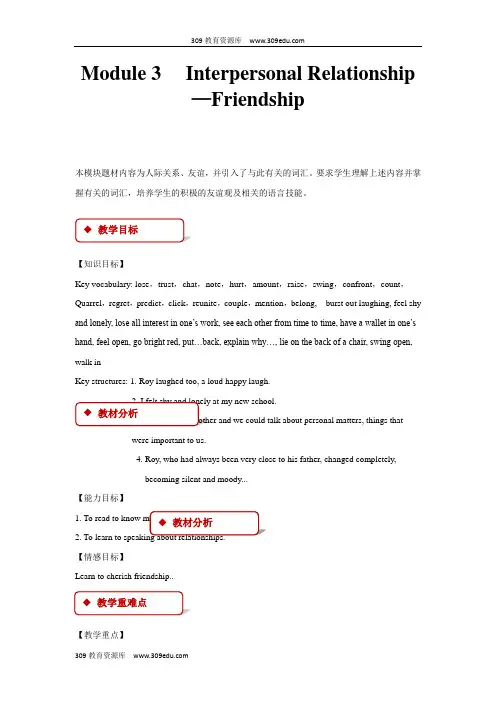
Module 3 Interpersonal Relationship—Friendship本模块题材内容为人际关系、友谊,并引入了与此有关的词汇。
要求学生理解上述内容并掌握有关的词汇,培养学生的积极的友谊观及相关的语言技能。
【知识目标】 Key vocabulary: lose ,trust ,chat ,note ,hurt ,amount ,raise ,swing,confront ,count , Quarrel ,regret ,predict ,click ,reunite ,couple ,mention ,belong, burst out laughing, feel shy and lonely, lose all interest in one’s work, see each other from time to time, have a wallet in one’s hand, feel open, go bright red, put…back, explain why…, lie on the back of a chair, swing open, walk inKey structures: 1. Roy laughed too, a loud happy laugh.were important to us.4. Roy, who had always been very close to his father, changed completely,becoming silent and moody...【能力目标】【情感目标】Learn to cherish friendship..【教学重点】To learn about Interpersonal Relationships — Friendship【教学难点】1. To learn to write a paragraph on the subject: H ow … and I became good friends2. 非谓语动词的having done 形式;非谓语动词的-ing 形式和to do 形式。
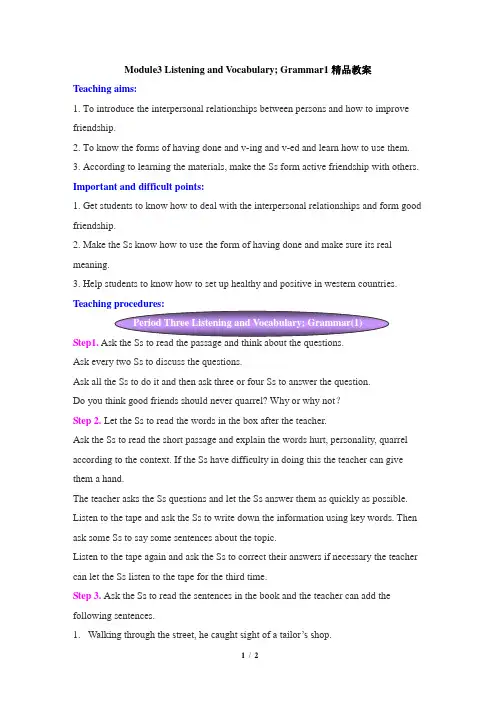
Module3 Listening and Vocabulary; Grammar1精品教案Teaching aims:1. To introduce the interpersonal relationships between persons and how to improve friendship.2. To know the forms of having done and v-ing and v-ed and learn how to use them.3. According to learning the materials, make the Ss form active friendship with others. Important and difficult points:1. Get students to know how to deal with the interpersonal relationships and form good friendship.2. Make the Ss know how to use the form of having done and make sure its real meaning.3. Help students to know how to set up healthy and positive in western countries.Step1.Ask every two Ss to discuss the questions.Ask all the Ss to do it and then ask three or four Ss to answer the question.Do you think good friends should never quarrel? Why or why not?Step 2. Let the Ss to read the words in the box after the teacher.Ask the Ss to read the short passage and explain the words hurt, personality, quarrel according to the context. If the Ss have difficulty in doing this the teacher can give them a hand.The teacher asks the Ss questions and let the Ss answer them as quickly as possible. Listen to the tape and ask the Ss to write down the information using key words. Then ask some Ss to say some sentences about the topic.Listen to the tape again and ask the Ss to correct their answers if necessary the teacher can let the Ss listen to the tape for the third time.Step 3. Ask the Ss to read the sentences in the book and the teacher can add the following sentences.1.Walking through the street, he caught sight of a tailor’s shop.2.Playing football on the ground, he hurt his leg.The teacher tells the Ss about having done using the designed questions in the book and the added examples.1.The form of having done means the action happens before the main action, but the form of doing means the action and the main action happens at the same time.2.The form of having done has the same subject as the form of doing.3.The forms of having done and doing all express initiative to the subject.Step 4. Ask the Ss to finish the exercises in Activity2, but the teacher must let the Ss compare the form of having done with the form of doing.For exampleActivity2I felt shy and lonely at my school because I had lost all my old friends.Having lost…I enjoyed my stay in London better than my friend because I know English. Knowing English…Activity4After I had been to his house a few times, I started to get to know his family. Having been to…When he heard the news, he let out a cry of surprise.Hearing the news…The teacher can add the following exercises to strengthen the Ss’ understanding about the form of having done and the form of doing.1.The dog jumped and ran forward, _______ (follow) his master.2.______ (carry)out the task ahead of time, he was praised by his boss.3.The students were in high spirits, ______ (sing) all the day.4.______ (live) there for a long time, he is used to the food there.5.______ (hurry)into the room, he noticed something unusual.6.______(walk)home along the street, he came across an old friend.7.______ (not receive)an answer, he wrote to him again.。
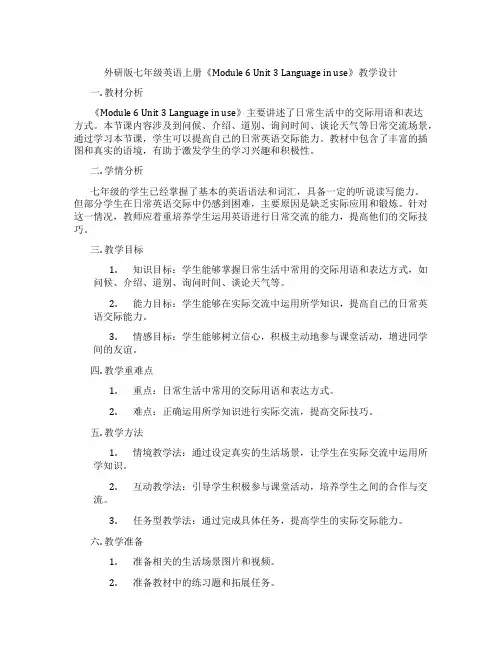
外研版七年级英语上册《Module 6 Unit 3 Language in use》教学设计一. 教材分析《Module 6 Unit 3 Language in use》主要讲述了日常生活中的交际用语和表达方式。
本节课内容涉及到问候、介绍、道别、询问时间、谈论天气等日常交流场景,通过学习本节课,学生可以提高自己的日常英语交际能力。
教材中包含了丰富的插图和真实的语境,有助于激发学生的学习兴趣和积极性。
二. 学情分析七年级的学生已经掌握了基本的英语语法和词汇,具备一定的听说读写能力。
但部分学生在日常英语交际中仍感到困难,主要原因是缺乏实际应用和锻炼。
针对这一情况,教师应着重培养学生运用英语进行日常交流的能力,提高他们的交际技巧。
三. 教学目标1.知识目标:学生能够掌握日常生活中常用的交际用语和表达方式,如问候、介绍、道别、询问时间、谈论天气等。
2.能力目标:学生能够在实际交流中运用所学知识,提高自己的日常英语交际能力。
3.情感目标:学生能够树立信心,积极主动地参与课堂活动,增进同学间的友谊。
四. 教学重难点1.重点:日常生活中常用的交际用语和表达方式。
2.难点:正确运用所学知识进行实际交流,提高交际技巧。
五. 教学方法1.情境教学法:通过设定真实的生活场景,让学生在实际交流中运用所学知识。
2.互动教学法:引导学生积极参与课堂活动,培养学生之间的合作与交流。
3.任务型教学法:通过完成具体任务,提高学生的实际交际能力。
六. 教学准备1.准备相关的生活场景图片和视频。
2.准备教材中的练习题和拓展任务。
3.准备课堂用的道具和物品。
七. 教学过程1.导入(5分钟)通过展示生活中常见的场景图片和视频,引导学生谈论相关话题,激发学生的学习兴趣。
例如,展示一幅公园的场景图片,让学生猜测图中人物在做什么,并试着用英语表达。
2.呈现(10分钟)教师通过讲解和示范,呈现本节课的主要内容和交际用语。
如问候、介绍、道别、询问时间、谈论天气等。
北大附中深圳南山分校高中组张树玲教案Module 3 Interpersonal Relationship—Friendship——Roy’s StoryZhang Shuling from the Affiliated High School of Peking UniversityI. Teaching Contents:Module 3 Interpersonal Relationship—Friendship (the second period)(Book 6 published by Foreign Language Teaching and Research Press, 2006)Reading and Writing: Roy’s StoryThis lesson includes three parts:Part I: Introduction (Friend and Friendship)Part II: Reading of Roy’s StoryPart III: Writing (Task-based Writing)Part IV: HomeworkII: Teaching Aims:a)Knowledge Objectives:☆To know well about some adjectives which are used to describe friends, such as encouraging, faithful, reliable, hard-working, forgiving, humorous, narrow-minded, impatient, gossipy, bad-tempered etc.☆To master some useful and practical phrases such as burst out laughing/ into laughter, think to oneself, knock sb over, lost interest in, go through, go bright red, turn round, raise money etc.☆To grasp a detailed idea of Roy’s Story.b) Competence Objectives:☆To master some practical reading skills to crack detailed information cases and the main idea cases in Reading Comprehension section and develop the ability in scanning a passage for useful information.☆To cultivate the awareness of group work and promote the ability of cooperation and communication in a group.☆To further enhance their ability in task-based writing and encourage the students to be confident to “show off” their writing work.c)Emotion Objectives:☆To learn what kinds of qualities a good friend should have and encourage the students to be such persons.☆To know what true friends and friendship are like and ask the students to value and cherish their existing friends.☆To promote their willingness in learning English.III.Key Points (Main Focuses)☆Read the passage and get the useful information for these two kinds of cases in reading comprehension :detailed information cases and main idea cases, especially the main idea (summary) of the whole passage.☆Task-based writing according to the passage.IV.Difficult Points:☆The summary of the whole passage.☆The task-based writing.V.Teaching Aids:Multi-media, Learning-guide materials.VI.Teaching Procedure:Step1. Warming up:The lesson starts with a poem concerning friends to encourage the Ss to talk about their best friend.Don’t walk in f ront of me,I may not follow.Don’t walk behind me,I may not lead.Walk beside me and be my friend.The students can talk about their best friends with the following leading questions:•Who is your best friend?•What is he/she like?•How long have you known him/her?•How did you first meet each other?•How often do you see each other?•Did you ever quarrel?•Do you think you will always keep in touch?Step II. After the small talk about their own friends, ask the students to summarize what kinds of qualities a good friend should have or shouldn’t have. This step aims to arise the Ss’ awareness of being a good friend of others.And then make a summary of what friends are.1.Friends are the sunshine of life.2. A friend is one who believes in you when you have ceased to believe in yourself.3. A friend is someone who understands our silence.4. A friend is the one who comes in when the whole world has gone out.5. A friend is a person who remains true and faithful to us the whole life.Step 3 Talk about what friendship is. Here is another poem regarding friendship. Ask the Ss to fill in the blank according to the hints in the poem, which helps the Ss to understand friendship deeply.When it rains, I think friendship is a small ____________.It can give me a patch of clear sky.When I’m crying, I think friendship is a white ___________.It can wipe my tears away.When I am sad, I think friendship is a warm ___________.It can bring me happiness again.When I am in trouble, I think friendship is a strong __________.It can help me escape my troubles.(umbrella, handkerchief, word, hand)Step 4. After the talking about friend and friendship, ask the Ss the question:If your friend has made mistakes, what will you do? Talk about the open question and then ask the Ss to read the passage—Roy’s Story. Meanwhile ask them to finish the exercises which are designed to demonstrate the ways to crack detailed information cases and the main idea cases in reading comprehension section.1.Look through para1—2 and choose the best answer.1)Where did the story happen?A. in the north of EnglandB. in LondonC. in the north of London2) Daniel could see that ________.A. Roy often told jokesB. People liked RoyC. Roy was always happy3) From para 2, we know Roy and Daniel became _________.A. close friendsB. friendlyC. friendsThe main idea of Part I (para1—2): _____________________________________________________.(I got to know Roy and made close friends with him.)2. Read para 3 and answer the question1) What caused Roy to change? _______________________________________________.(His father’s death)2) After Roy’s father was killed, Roy’s family moved ___________.A. because of money problemB. because they didn’t want to stay in the same houseC. because their house was so big3) Roy became _________ to me.A. less cleverB. less friendlyC. less interestingThe main idea of Part II (para3): ________________________________________________.(Roy changed completely after his father’s death in a car accident.)3. Read para 1—3 again and answer the questions.1) What was Roy like before his father died? (at least 4 characteristics)________________________________________________________________________.(He was popular, kind, clever, and hardworking. He was happy, outgoing, funny.)2)After his father’s death, how did Roy change? ________________________________________________.(He became silent and moody. He lost all interest in his work and started to lose friends.)Stop for a while and Ask the Ss to think : What would you do if your good friend changed like this? (Open question)4. Read para4—5 and choose the best answer:1) When Daniel found Roy with someone’s wallet, ________.A. Roy was not embarrassed.B. Daniel looked at him angrily.C. Daniel looked at him in surprise.2) Daniel thought that the person stealing from students (para.5) _________.A. might be RoyB. was RoyC. was someone he knewThe main idea of part III (para4—5):_________________________________________.(I found Roy stole other student s’ wallets.)5. Read para6—8 and choose the best answer:1) The £500 was raised __________.A. for someone in needB. for the school fairC. for the class teacher2) The money in Roy’s pockets _________.A. was almost certainly the money from the fairB. had been stolenC. was probably money that Roy had made recentlyThe main idea of part IV (para6—8) ________________________________________.(I found Roy stole the money raised for a charity by accident.)Step 5 Fill in the blank and see what Roy did and how the writer reacted to it. Then talk about the problem “If your friend has made mistakes, what will you do?” (open question)Ask the Ss to evaluate Daniel’s reactions to Roy’s wrong actions and think “If you were Daniel, what you would do.”Step 6 Useful and practical phrases.1. 大笑起来burst out laughing / into laughter2. 心里想think to oneself3. 逐渐知道get to know4. 撞伤撞死knock sb over5. 靠近be close to6. 对……失去兴趣lost interest in7. 偶尔,时不时地from time to time/ at times8. 检查、翻看、经历go through9. 变得通红go bright red10. 转身turn round11. 同时at the same time12. 筹钱raise money13. 举起、耽搁hold up14. When he reached the final line, everyone burst out laughing.他说到最后一句话时,大家都哄堂大笑。